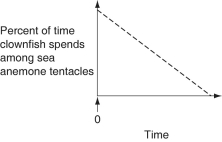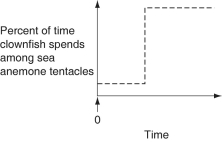Multiple Choice
The following questions refer to the paragraph below.
An elementary school science teacher decided to liven up the classroom with a salt-water aquarium. Knowing that salt-water aquaria can be quite a hassle, the teacher proceeded stepwise. First, the teacher conditioned the water. Next, the teacher decided to stock the tank with various marine invertebrates, including a polychaete, a siliceous sponge, several bivalves, a shrimp, several sea anemones of different types, a colonial hydra, a few coral species, an ectoproct, a sea star, and several gastropod varieties. Lastly, some vertebrates-a parrotfish and a clownfish-were added. She arranged for daily feedings of copepods and feeder fish.
-The clownfish readily swims among the tentacles of the sea anemones; the parrotfish avoids them. One hypothesis for the clownfish's apparent immunity is that these fish slowly build a tolerance to the sea anemone's toxin. A second hypothesis is that a chemical in the mucus that coats the clownfish prevents the nematocysts from being triggered. Which of the following graphs supports the first, but not the second, of these hypotheses? (The clownfish, which had never before been in the presence of a sea anemone, and sea anemones were introduced to the same aquarium at Time 0.)
A) 
B) 
C) 
D) 
Correct Answer:

Verified
Correct Answer:
Verified
Q2: While vacationing in a country that lacks
Q3: Of the annelid classes below, which make
Q4: The following questions refer to the paragraph
Q8: Which of the following have distinct central
Q9: A terrestrial animal species is discovered with
Q10: Which of the following describe(s)echinoderms?<br>A)They have an
Q11: The following questions refer to the paragraph
Q37: Infection with which parasite might cause excessive
Q45: A farm pond, usually dry during winter,
Q70: Among the invertebrate phyla, phylum Arthropoda is